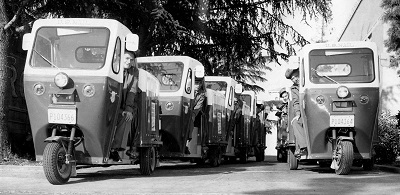Tidings
Beyond the Hat: Napa County Post Offices, 1850 – 1900
This is an excerpt of an article written by one of our long-time volunteers, and was first published in the Vol. 22, No. 1 edition of Tidings, our quarterly newsletter. To get your copy of Tidings, become a member today!
 In this era of accelerating electronic communication and dwindling United States post offices, it may be surprising to learn that 34 were established in Napa County between 1850 and 1900. Because residents at that time often lived in far-flung settlements (including, by the 1870s, mining camps), post offices were located wherever possible to service those areas. Mail arrived by steamer, stagecoach, horse and buggy – whatever was available and practicable. It took another 30 years before a postal car attached to a passenger train brought mail into the county, twice daily. Mail sacks were taken from the car near each of the established post offices along the train’s route. From there, mail was delivered to the outlying post offices by horseback, wagon, or stage – with surprising regularity.
In this era of accelerating electronic communication and dwindling United States post offices, it may be surprising to learn that 34 were established in Napa County between 1850 and 1900. Because residents at that time often lived in far-flung settlements (including, by the 1870s, mining camps), post offices were located wherever possible to service those areas. Mail arrived by steamer, stagecoach, horse and buggy – whatever was available and practicable. It took another 30 years before a postal car attached to a passenger train brought mail into the county, twice daily. Mail sacks were taken from the car near each of the established post offices along the train’s route. From there, mail was delivered to the outlying post offices by horseback, wagon, or stage – with surprising regularity.
The mail made its way to the appropriate post office, and, as no U.S. mail carriers existed (until 1898 in Napa and 1907 in St. Helena), it was the recipient’s responsibility to retrieve her or his mail. Local newspapers did provide a helpful “Mail Call” column, listing mail not yet picked up. After two weeks that mail went to the “Dead Letter Office” (DLO). The true purpose of the U. S. Post Office’s DLO was to assess “mystery mail” deemed undeliverable because of missing or incorrect addresses. In early Napa County, as elsewhere, the mail sent to the DLO was undeliverable simply because no delivery service existed beyond the local post office. The situation was a bit easier in “Nappa” City. [Ed. note: this was the original spelling of “Napa” when first laid out by Nathan Coombs in 1847] C. P. Briggs was appointed the city’s first postmaster, April 9, 1850. Briggs carried the mail in his hat – a combination repository and carrier. He did not actually deliver your mail; if you met him on the street, you asked him if he had anything for you in his hat.
Until about 1857, Napa County’s post offices were limited to Napa, Sebastopol (later re-named Yountville), St. Helena, and Oakville. With the discovery of cinnabar, mining opportunities swelled, and more and more outlying settlements were established near mineral resources. Some of these settlements happened to lie within the northernmost area of Napa County, an area lost in the 1860s when Lake County was created from portions of Napa and Mendocino Counties. Between 1858 and 1862, Upper Clear Lake, Big Valley (Lakeport), Lower Lake, Uncle Sam (Kelseyville), Kayote (near Middletown), and Knoxville all lay within Napa County’s “Clear Lake Township,” and each had its own post office. Knoxville was returned to Napa County following an 1872 boundary adjustment, and its post office existed until 1912, possibly at the Wilson Inn, aka Howell House, according to a 1972 Jess Doud-KVON interview (see: NCHS Oral History Collection).
An additional settlement within Napa County in 1860 was Knight’s Valley, with two post offices, Albany and Kellogg, the latter located near Florentine Kellogg’s ranch northwest of Calistoga. In 1878, following a lengthy legal dispute involving, not surprisingly, mineral and geyser rights, Napa County lost Knight’s Valley to Sonoma County.
Between 1863 and 1874, post offices were established at Pope Valley, Calistoga, Monticello, Carneros, Suscol, and Adelante (Napa Junction), the last three discontinued by 1871. Additional offices sprang up in Rutherford, Capell, the Phoenix Mine (for a seven-year run), and briefly at Spruce Hill, near the community of Redwood southeast of Lokoya. And the Napa Junction and Soscol (no longer “Suscol”) post offices were re-opened.
From mid-1880 to late-1888, post offices sprouted at Lidell (named for the then-proprietor of Aetna Springs), Napa Soda Springs, Angwin, and Chiles, all of them lasting into the twentieth century and, in the case of Angwin, to present day. In 1881, a former Lake County post office at Zem-Zem Springs (a source of onyx marble) came Napa County’s way. According to Walter Frickstad’s A Century of California Post Offices, 1848-1954, no record of the post office was found, but a Lake County source implies a minor boundary change shifted Zem-Zem into Napa County. And, in the 1890s, post offices were established at the Oat Hill Mine, Veteran’s Home, Atlas Peak, Lomitas (within or near Rancho Catacoula near Chiles Valley), Trubody (about four miles north of Napa near today’s Trubody Lane), Rector (either in Foss Valley on Atlas Peak or near the base of that mountain), and Wooden Valley (rescinded three days later for an unknown reason).
The establishment or removal of these post offices reflected ongoing changes in demographics, economics, governmental policies, and modes of transportation, all of which led to the passing of Napa’s early small settlements. When, in 1910, the Oat Hill Mine area could no longer justify a post office, Calistoga’s post office received their mail. Napa Soda Springs’ post office ceased operation in 1929, its mail transferring to Napa. As automobiles became more affordable, “going into town” became easier. Losing its Spruce Hill post office in 1875, the community of Redwood (near today’s Mt. Veeder School and Redwood Cemetery and named for the area once known as “the Napa Redwoods”) likely became less autonomous. Lomitas, a “prosperous farming community” located in the Chiles Election District between 1895 and 1915, saw their post office subsumed in 1908 to the larger station in Chiles Valley, which was in turn subsumed by St. Helena in 1924. What was gained and what was lost as these communities fragmented? That is a question for another day and another writer.
As for the City of Napa, the first Napa Post Office was built in 1856 on East First Street near Napa River, in a building named for Mr. Briggs, our man with the hat. In 1880, the next location was at First and Brown Streets. In 1898, the post office moved again – to the 1100 block of Main Street. In 1926, the location was at Third and Coombs. The final move occurred in 1933 – to 1351 Second Street, where it has been known as the Franklin Station (closed since the August 24, 2014 earthquake) since the 1965 construction of the Napa Station at 1625 Trancas Street.
One related mystery remains. Among Napa County Historical Society’s photo collection is an old, undated shot of a small wooden building sporting a large sign reading “Inglenook Post Office.” This post office is not found in any related sources and may be a future research project.


